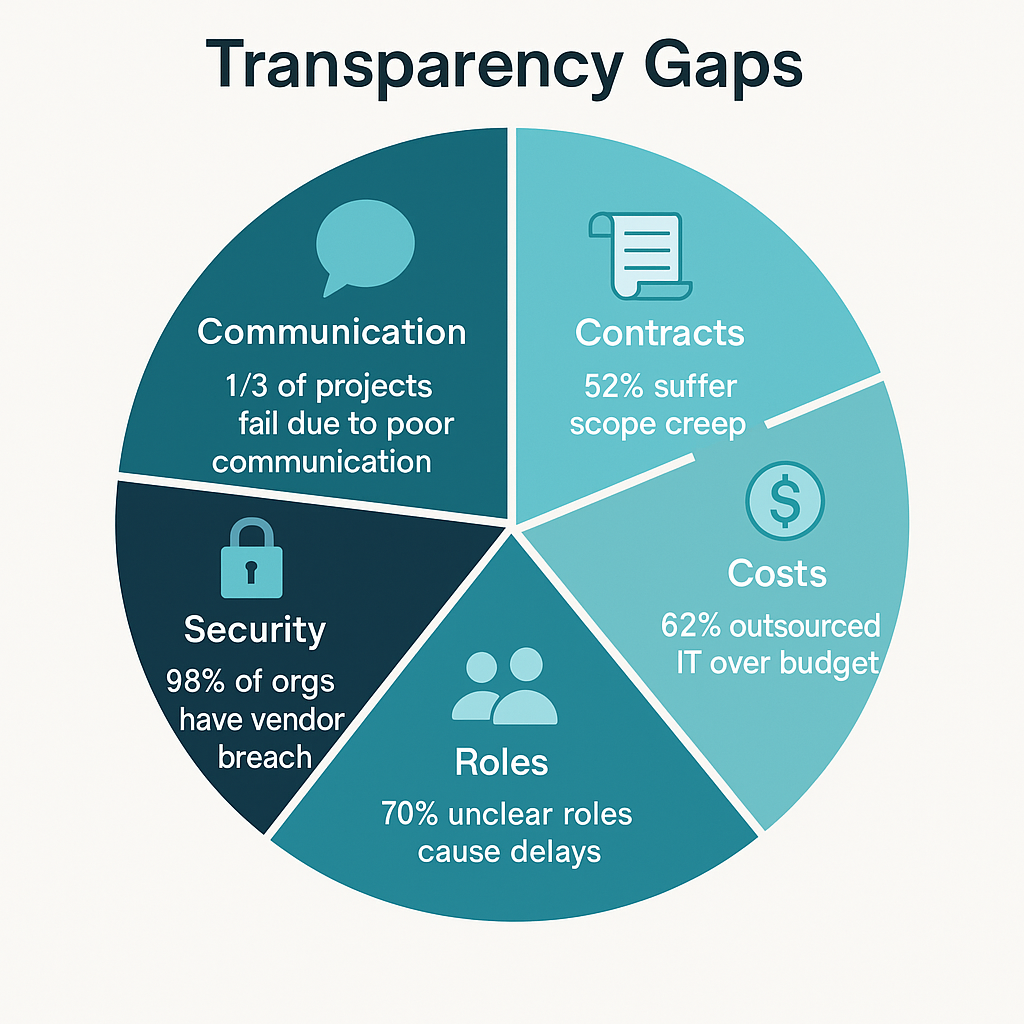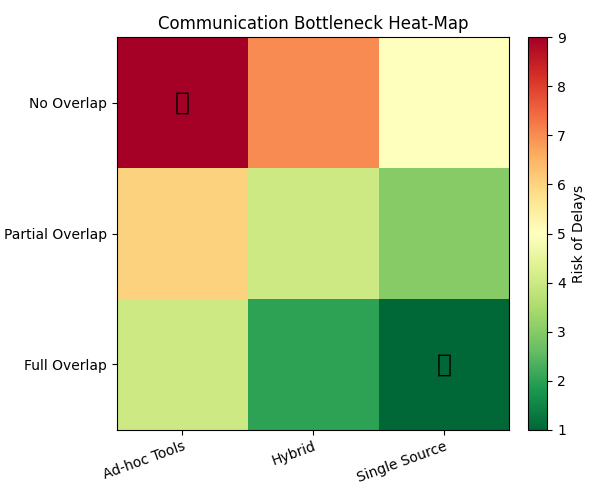
Common Transparency Challenges in Outsourcing
Ensuring transparency in outsourcing can be challenging due to a variety of factors that complicate communication and collaboration.
Cultural and Language Barriers
After more than a decade of helping businesses extend their teams, we’ve seen firsthand the incredible potential of outsourcing. But we’ve also seen where the pitfalls lie, turning promising partnerships into sources of frustration and unmet expectations. The global outsourcing market is booming, expected to grow from over $300 billion in 2024 to more than $525 billion by 2030, as 74% of employers report struggling to find the skilled talent they need. However, this rapid growth also highlights a critical challenge: a lack of transparency.

True transparency in outsourcing is far more than a buzzword; it’s the bedrock of a successful partnership. It’s about building a foundation of trust that allows for honest, open, and sometimes difficult conversations. Without it, even the most well-intentioned collaborations can falter, leading to project delays, budget overruns, and damaged relationships.
Here are some of the most common transparency challenges in outsourcing, backed by our experience and industry data, and – most importantly – how to solve them.

1. Communication and Collaboration Breakdowns
Effective communication is the lifeblood of any project, but its importance is magnified in an outsourcing context. Studies show that ineffective communication is a primary contributor to project failure one-third of the time and negatively impacts success in over half of all projects. When teams are separated by geography, language, and culture, maintaining clear and consistent communication requires a proactive and structured effort.

- Cultural and Language Barriers: It’s not just about speaking the same language; it’s about understanding cultural nuances. Communication styles vary dramatically across the globe. A direct, to-the-point style in one culture might be perceived as rude or aggressive in another, while a more indirect, high-context style can come across as vague or non-committal. These differences can lead to significant misunderstandings, misaligned expectations, and friction that erodes trust.
- Time Zone Differences: While a global team offers the advantage of a continuous work cycle, it can also create significant communication bottlenecks. A lack of overlapping work hours can delay crucial decisions, stall problem-solving, and make it difficult to address urgent issues promptly. This can leave team members feeling disconnected and out of the loop, impacting morale and overall project momentum.
- Ineffective Communication Channels: When there are no standardized communication protocols, chaos ensues. Information gets lost in sprawling email chains, misunderstood in fragmented chat messages, or siloed in different software platforms. This “tool sprawl” creates confusion and inefficiency. High-performing organizations are nearly twice as likely to create formal communication plans for their projects, ensuring a single source of truth and clear channels for every type of interaction.

2. Contractual and Financial Ambiguity
A well-defined contract is the roadmap for a successful outsourcing relationship. Ambiguity in this foundational document is a recipe for disputes, disappointment, and financial loss.
- Vague or Incomplete Contracts: A contract that lacks specifics on the scope of work, deliverables, timelines, and responsibilities is a major red flag. Without these clear definitions, it becomes nearly impossible to track performance, measure success, or ensure accountability. This ambiguity is a leading cause of scope creep, which affects 52% of projects and can add 10-20% to the budget.
- Hidden Costs and Lack of Financial Transparency: While cost savings was once the primary driver for outsourcing, today, only 34% of businesses cite it as the main reason. Yet, financial clarity remains critical. Hidden fees and opaque pricing structures can quickly erode any potential savings and destroy trust. These can include unexpected charges for revisions, additional support, currency fluctuations, or infrastructure needs. Outsourced IT projects are more than twice as likely to go over budget compared to in-house projects (62% vs. 27%), often due to these unforeseen costs.

3. Operational and Security Challenges
Beyond communication and contracts, a lack of transparency in day-to-day operations and security protocols can introduce significant risk.
- Lack of Openness and Accountability: In a healthy partnership, both sides should feel safe to report mistakes, delays, or challenges without fear of reprisal. When this psychological safety is absent, there is a reluctance to be forthcoming, causing small, fixable issues to snowball into major crises. This culture of fear can hide underlying quality problems until it’s far too late to address them effectively.
- Inconsistent Reporting and Documentation: Without regular, detailed progress reports, clients are essentially flying blind. A lack of consistent documentation on milestones, risks, and performance metrics makes it impossible to gauge the true status of a project. This not only hinders effective oversight but also makes it difficult to identify and address potential issues before they derail the entire engagement.
- Unclear Roles and Responsibilities: When team members on both the client and provider side are unsure of their specific roles, tasks inevitably fall through the cracks. This leads to duplicated efforts, missed deadlines, and a breakdown in accountability. A simple tool like a RACI (Responsible, Accountable, Consulted, Informed) matrix can provide immense clarity and improve overall efficiency.
- Data Security and Confidentiality: Entrusting an external partner with sensitive data carries inherent risks. A staggering 98% of organizations have at least one third-party vendor that has suffered a data breach. A lack of transparency around security protocols, data handling practices, and compliance certifications (like ISO or GDPR) can create significant vulnerabilities. The average cost of a data breach reached an all-time high of $4.88 million in 2024, and the involvement of a third party can increase that cost significantly.

Overcoming Transparency Challenges for a Strategic Advantage
Building a transparent outsourcing relationship isn’t about avoiding challenges—it’s about creating a framework to navigate them successfully. This requires a proactive, intentional approach from the very beginning.
- Establish Ironclad Communication Protocols: Don’t leave communication to chance. From day one, agree on primary communication channels, meeting cadences for different purposes (daily stand-ups, weekly reviews), escalation paths for issues, and a centralized project management tool to serve as the single source of truth.
- Develop a Radically Clear Contract: Invest the time to create a detailed and comprehensive contract. This document should explicitly outline the scope of work, deliverables, timelines, payment schedules, and the specific responsibilities of each party. Crucially, it should also include well-defined Service Level Agreements (SLAs), Key Performance Indicators (KPIs), intellectual property rights, and a clear exit strategy.
- Foster a Culture of Openness and Trust: True transparency is built on a foundation of psychological safety. Encourage open dialogue where both parties feel comfortable raising concerns, admitting mistakes, and providing honest feedback without fear of blame. Celebrate transparency and treat challenges as collective problems to be solved together.
- Demand Robust Reporting and Documentation: Define your reporting requirements in the contract and hold your partner accountable. This should include regular, detailed updates on progress, budget tracking, risk logs, and performance against KPIs. This ensures everyone is on the same page and that data—not assumptions—is driving decisions.
- Conduct Rigorous Due Diligence: Before signing any contract, thoroughly vet potential partners. Go beyond their sales pitch and look for a proven track record of transparency and reliability. Ask for client testimonials, review case studies, and inquire specifically about their security practices, compliance certifications, and data protection policies.
By prioritizing these steps, you can transform transparency from a potential challenge into your greatest strategic advantage, building a strong, resilient, and successful outsourcing partnership that delivers exceptional results.
Ready to build a transparent and effective extended team for your next project? Contact us today!